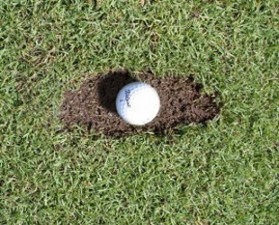
Divot
One of the essential terms in golf is “divot.” It refers to a piece of turf that is displaced or removed when a golfer strikes down on the ball with their club, usually during a full swing. Divots are often seen on the fairway or tee area where golfers take their shots.
Divots occur due to the angle at which the clubhead strikes the ball and the grass beneath it. When a golfer executes a proper swing, the clubhead should hit the ball first, and then the turf. This sequence ensures a clean shot and optimal distance. However, sometimes golfers hit the ground before contacting the ball, resulting in a divot.
Divots can vary in size depending on several factors, such as the type of grass, the angle of the club, and the force applied to the shot. Here are a few key aspects to understand about divots:
- Size: Divots can range from small to large chunks of turf.
- Shape: Divots are typically irregular in shape and often have a crescent or triangular appearance.
- Turf Depth: The depth of a divot can indicate how steeply the golfer struck the ground.
- Direction: Divots generally point in the direction of the golfer's swing.
- Repair: Golfers should make an effort to repair their divots to maintain the course's condition.
Repairing divots is not only a courteous behavior but also crucial for maintaining the quality of the golf course. Here are some reasons why golfers should repair divots promptly:
- Course Aesthetics: Divots can make the fairway or tee areas look rough and unkempt.
- Playability: Unrepaired divots can create uneven surfaces, affecting subsequent shots for other players.
- Turf Health: Divot repair helps the affected grass recover faster and prevents diseases or weeds from taking hold.
- Conservation: By repairing divots, golfers ensure the efficient use of resources and help conserve the environment.
Repairing a divot is relatively simple and only requires a few steps:
- Retrieve the displaced turf chunk or collect loose grass nearby.
- Place the turf chunk back into the divot, aligning it with the surrounding grass.
- Press down on the repaired divot with your foot or club to ensure it is firmly in place.
Some golf courses provide sand and seed mixtures in divot boxes on the fairways. If available, golfers can also use these mixtures to fill divots and promote faster recovery.
Remember, repairing divots is an essential golf etiquette that all golfers should follow. By doing so, we can contribute to the maintenance and enjoyment of the course for ourselves and others.
- Fat Golf Shot Drill: Mark ball position with tee to see divot Video – Lesson 21 by PGA Pro Pete Styles
- Fat Shot Golf Drill: Mark Ball Position with Tee to See Your Divot
- Which is Best Sweeping Swing or Take a Divot Women Golfer Tip Video – by Natalie Adams
- Which Is Best: Sweeping Swing or Take a Divot? Women Golfer Tip





